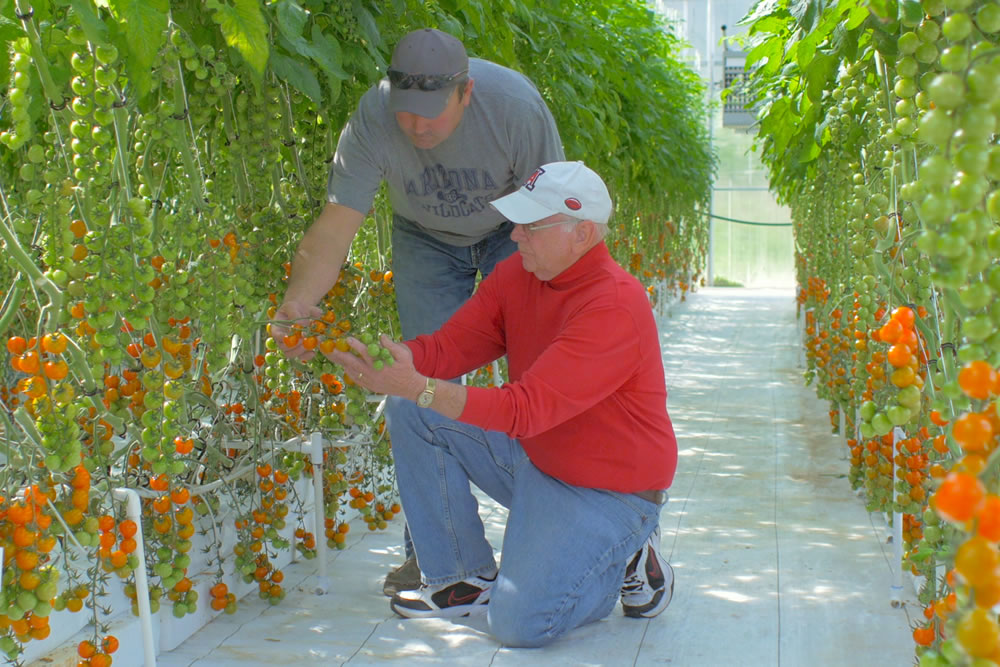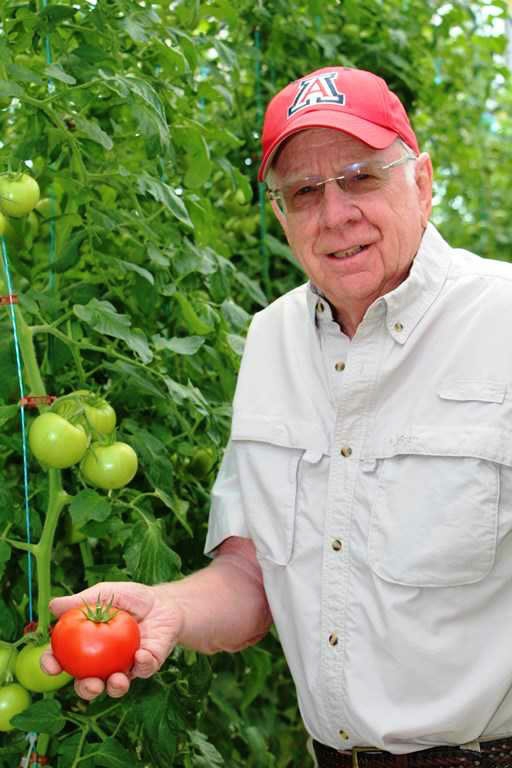
Dr. Merle Jensen is the Henry Ford, Steve Jobs and Albert Einstein of the present and the future of controlled agricultural greenhouse systems all rolled up into one person. By helping to feed the inhabitants of approximately 50 countries, and teaching his greenhouse growing systems to literally thousands of farmers worldwide, Jensen has a resume and a legacy that is impressive, to say the least.

Dr Merle Jensen in an Agra Tech Solar Light Greenhouse
Dr. Merle Jensen has served as an academician and consultant to the agriculture industry for over 40 years, developing agricultural systems for businesses, communities, and aerospace applications. He was one of the early pioneers in the development of agricultural plastics for greenhouses and brought one of the first Dutch Venlo glasshouses to the United States. Early in his career, Jensen was recognized internationally for his groundbreaking research on tomato viruses and mineral nutrition for both horticultural and agronomic crops.
Jensen, 77, has developed intensive agriculture/food support systems for developing agricultural communities and aerospace application. Some of his interests include programs in protected agriculture, the growing of horticultural crops out of season using agricultural plastics for modification of the microclimate. Coinciding with these research interests is the application of new systems of protected agriculture to developing agricultural programs throughout the world. These research interests extend to a recent program with NASA in comparing plant growth and reproduction in hydroponic liquid culture versus solid media food production techniques for a “Closed Ecological Life Support System” (CELSS).
He developed many of the cultural systems for controlled environment agriculture used in over 50 countries, including drip irrigation, growing media, solar energy, energy alternatives and conservation for greenhouse vegetable production. Through his fund-raising efforts, he was able to establish the Controlled Environment Agriculture Center at the University of Arizona, which serves today as the only such research/education center of its kind for university students in the country.
Maybe I’m best known for the work that I did with the Walt Disney Company as one of the senior designers of an attraction called Living with the Land (a boat tour ride located within The Land Pavilion which is part of the Epcot theme park in Walt Disney World Resort at Lake Buena Vista, Florida. It is a slow-moving boat ride, which is part dark ride and part greenhouse tour. The focus of the ride is on agriculture, especially new technology to make agriculture more efficient and environmentally friendly.) I started working on that in 1975 and we opened up the attraction in 1982. The designs are from the University of Arizona and I was involved with that project for at least a decade. 135 million people have come through that attraction.
Since then, I’ve been able to work in 50 countries to develop agricultural systems throughout the world and introduce new methods to them to grow more food. I guess you’d call me an Agriculture Futurist, because my focus is always where are we going in the future and what do we have to do about it regarding things such as production of vitamins and minerals in our plants.
This is a very exciting time in this industry, because these closed systems are being installed all over the planet. Open field agriculturists are now looking around and saying–hey what is happening, because things are moving quickly. Today’s deep hydroponic flow systems or growing in synthetic soils–those are the systems that I brought to the United States starting back in 1968. We then introduced them to the rest of the world and many of them ended up in the Disney attraction. We designed these systems at the University of Arizona and today they are used in countries like Abu Dhabi, Morocco, Guatemala, Mexico, Iran, Egypt–all over the world. We have taken these modernized systems and helped a country like Mexico in a big way. We have taken 800 farmers in Mexico and educating them about how to grow tomatoes, peppers and cucumbers, for example, in greenhouses and providing jobs for a country that has a lot of labor. We’ve done this all over the world and changed the industry in those countries.
I was challenged in the late ’80s with developing a resort in Anguilla in the Caribbean for the people at Cuisinart, the company that makes appliances for the kitchen. They saw what we did for Disney and they wanted to do something similar in Anguilla. So, we developed the Cuisinart Resort and during the design phase I realized that I needed a greenhouse that was tough. It needed a company that could work with me, because I had designs that would need to withstand 100 mph winds. So, I called the late Bob Pound, John Pound’s father and we started working together. He was a great help to me and a great person to work with. When Bob passed, I began working with John and now I work with John’s son, Adam Pound. So, they built that greenhouse for Cuisinart and then others here where I live in Washington State. I recommend them, because they build a great greenhouse and their pricing is fair. We’ve done real well with Agra Tech and the Pounds have been instrumental in several projects we’ve worked together on.
Look at it this way. In the ground, you can grow one crop of lettuce and maybe one other crop every year on one acre. But, in the greenhouse you can grow that crop 60 times over. So, you’re getting 60 acres worth of lettuce from the equivalent of one acre in-ground and that number will increase as the technology evolves. So, what is the next step? The light sources; the hydroponics; synthetic soils and new fertilizers–all of these will change dramatically. But, I believe the biggest change will be with robotics. Once we legalize 12 million people who are mostly from south of the border, those people won’t want to work in agriculture anymore. They’ve been working under the radar for so long and it’s very physical work, so I think we’re going to have to look elsewhere for labor. So, that’s why I see a big thrust toward robotics in the controlled greenhouse environment in the future.
Written by Ed Attanasio
TrustED Advertising
Published on:
04/01/2016
Post by:
Admin
Category:
Greenhouses
Tag(s):
#Agra Tech
#Controlled agricultural greenhouse systems
#Controlled environment agriculture
#Dr. Merle Jensen
#Greenhouse growing industry
#Greenhouse growing systems
#Greenhouse systems
#Greenhouse vegetable production
#Solar Light Greenhouse
#University of Arizona
It hasn't been easy along the way for the Caribe Greenhouse Project. The buildings went through two hurricanes (Maria and Irma) during the construction and according to the company's licensed inspectors and engineers, there was little to no damage to the greenhouses. "The structures were half-built when the storms came, but they held up fairly well, which was impressive," Cabiya said. "They are made with sturdy and reliable components, so they only experienced only a few minor issues."
Read article: The Caribe Greenhouse Project
Caribe Greenhouse
Jose Cabiya
Juana Diaz, Puerto Rico